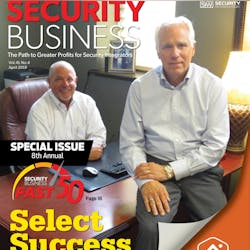During the course of a 40-plus year run as a business owner in the security industry, Patrick Egan has seen it all – the rise and fall of telephone-based security alarms; the analog-to-digital revolution; the entrance (and often, exit) of powerful businesses and players into the security market – the list goes on.
“I remember being in alarm association meetings years ago, where everybody was complaining about the doorknockers, and I stood up and said, ‘You can’t just have your customer be your customer for 20 years and never reach out to them again, and never talk to them about upgrading,’” Egan says.
“A few years later, I remember guys saying, ‘I’m not going to do door locks – we are not locksmiths or carpenters,’ and ‘I’m not doing thermostats – those are for HVAC guys, and we are not good at that.’
“Technology changes, and today you have got to do it all,” he continues. “Years ago, we interviewed and hired a technician with a tool belt; now, you better have a laptop, not necessarily a tool belt. The company needs to move forward at the same or exceeding the rapid pace of the technical changes.”
Change on the security business front can come in many forms – from technology, to technicians, to acquisitions – whether they are residential or commercial focused. Coping with those changes beneficially can lead to phenomenal success for security integrators. Such the case for Select Security, which, thanks to an aggressive M&A strategy coupled with healthy organic growth, has been named the fastest-growing security integrator in the 2019 Security Business Fast50.
The Road to Growth
Egan launched Lancaster, Pa.-based Select Security in 2003 following a 25-year success story as the founder of Commonwealth Security Systems and quickly established a foothold in the northeast before expanding westward in the years to come. By 2016, Select Security was established as one of the nation’s largest independently owned electronic security and life safety systems providers, and in June of that year, the company announced a new $55 million senior credit facility with the Goldman Sachs Specialty Lending Group that signaled the beginning of an aggressive acquisition plan.
For Egan, running the day-to-day security business has given way to spearheading this acquisitions strategy as CEO. “Finding the opportunities and getting them teed up and getting them closed is what I handle,” he says. “I get a few deals through brokers, but more often, I am out on the road meeting and talking to dealers, and I go find my own opportunities. We have dozens of opportunities right now on the acquisition side.”
One year after securing the funding, Egan and Select Security made what is by far the largest acquisition in its history, purchasing all of the U.S.-based accounts from AlarmForce in an $11.5 million deal that nearly doubled Select Security’s customer base by nearly 30,000. The move added thousands of customers in Florida, Georgia, North Carolina, Ohio and Minnesota.
“We have been very aggressive in upgrading those customers, replacing equipment and growing that customer base,” Egan says. “We have upgraded their equipment, secured new subscriber agreements and increased the recurring revenue – every one of those converted customers is now on the Alarm.com platform.”
In all, Select Security has made 15 acquisitions in the past two years – mostly concentrated on the east coast, but also as far west as Albuquerque. “A company of the size we are today is a very different animal than when I started Select Security in 2003,” Egan says. “Who would have thought that 16 years later, we would have more than 80,000 customers and 24 branch offices.”
Tying it all Together
Egan admits that “finding (acquisition) opportunities is not hard – there are plenty out there.”
The hard part comes next, when someone is tasked with folding these acquired companies – and their varying vendor partners, installation procedures, sales tactics, compensation plans, and the list goes on – into an already successful operation. That task falls on industry veteran Steve Firestone, Select Security’s President, who joined the company in 2012 to oversee its day-to-day operations.
“We have a very disciplined integration process, where we have a timeline that runs from the moment we hear about an acquisition opportunity all the way through the closing of the acquisition and 30, 60 and 90 days post-acquisition,” Firestone explains. “It is a process with clearly defined responsibilities on every possible line item of integrating that business into ours – ranging from how new people will be compensated, to what does the signage will look like on the building that we acquired, to central station-related issues, product rollout and transferring third-party vendor relationships with back-end service partners like Alarm.com. It is a disciplined, repeatable process that we try and follow with every single acquisition.”
Firestone says the secret to Select Security’s acquisition strategy lies in its ability to provide a disciplined and repeatable process to the integration of the new customers and employees.
To that end, Select Security has a dedicated team, led by Steve Roy, Director of Acquisition Integration and Technology Services, who is also a member of Select Security’s senior leadership team.
Joining Roy in this effort includes the rest of the senior leadership team: Bob Grove, VP of Operations; Rich Henry, VP of Sales; Joseph Mitton, Director of Marketing & Customer Experience; Alex Nitterhouse, Director of Sales Operations; Kip Luscian, Director of Administrative Services; and Bob Houck, Controller.
“When you do acquisitions, you get companies that may have sold a variety of different products over the lifespan of their business,” Firestone adds. “Now that they are our customers, we need to service the products that the predecessor companies used to sell. That said, as early as within 30 days of an acquisition, our leadership team pushes hard so that the sales organization and the field operations organization are converted to what we sell, because that drives our cost of operating the business down – we take a very concerted effort on doing an integration on the vendor side also.”
A Different Acquisition: RMR and Personnel
Outside of acquiring customers and companies, the two most important areas that Select Security addresses in its growth strategy are RMR and new employees. Firmly entrenched in both the residential and commercial sides of the industry, Egan says the company will not do any work without RMR.
Like most Fast50 companies, even being active in the acquisition space is not enough to satisfy an insatiable need for qualified, highly-trained talent. “By far, the number one challenge on anyone’s list is workforce development,” Firestone says. “We are not yet an industry that is a destination of choice for the kinds of people that we want to hire – and even if we are on the radar, there is a misperception by many that this industry is still your grandfather’s Oldsmobile, to use the old advertising phrase.
“That has required us to rethink how we recruit, how we train, how we continue to train, how we compensate, how we structure the organization, and what tools we need – not screwdrivers, but tools to run your business,” Firestone continues. “Our team has been forced to continually re-evaluate everything we do to stay ahead of the curve, because they know that the companies that get this right are the companies that are going to win.”
Firestone says that initiatives launched over the past few years by his team to engage employees with the success of the company include its well-received new employee onboarding classes that bring all new employees to Lancaster several times per year to introduce them to the organization, mission and culture – its Sacred Cow project that engages all employees in the evaluation of long-standing company processes, as well as its Cascade Transformation process that uses goals and company-wide transparency to build cross-department alignment.
The strategy is working for Select Security; in fact, Firestone reports that 27 percent of the workforce hired in 2018 was a result of direct reference from existing employees – a testament to senior leadership and hiring managers. “That says a lot about the process and the discipline we have as an organization,” Firestone says.
Dealing with Growth
With so much experience under his belt, Egan is eager to offer advice to growing business owners and managers; in fact, he has actually been giving it out in a series of seminars as part of the regional ADI Expo series.
“I get asked (for advice) a lot, and it comes down to the normal blocking and tackling of managing a business,” Egan says.
Adds Firestone: “The secret is in ‘repeatable discipline.’ In order to move fast; in order to be nimble enough to seize opportunities as they arise and make the most of them, organizations need to have the discipline to make a plan and stick with it. Know what works, and just keep doing it until you need to change.”
The Fast50 is a rankings and market research feature in Security Business open to all North American security integrators. To access the results from all eight years of Fast50 rankings and research, please visit www.securityinfowatch.com/fast50.
Paul Rothman is Editor-in-Chief of Security Business magazine. Email him your comments and questions at [email protected]. Access the current issue, full archives and apply for a free subscription at www.securitybusinessmag.com.
Select Security Acquisition Timeline – 2017-18
Jan. 2017 - George M. Brobeck Co., Aliquippa, Pa.
April 2017 - Carolina Security Holdings LLC, Charlotte
May 2017 - Southern Security Services, Nashville
June 2017 - AlarmForce LP, Canada; and Trinity Security Systems, Elizabethtown, Pa.
Oct. 2017 - Tennessee Valley Protection Services, Huntsville, Ala.
Nov. 2017 - Security Consultants Inc., Memphis
Dec. 2017 - Alert Alarm Systems Inc., Paducah, Ky.
Feb. 2018 - State Security, Roanoke, Va.; Garden State Fire & Security Alarm Co., Matawan, N.J.; Armed Response Team Inc., Albuquerque
March 2018 - DFW Security, Ft. Worth, Texas (Accounts Purchase)
April 2018 - Interactive Alarms, Nashville; YPS Integrated Systems, Warren, Ohio
May 2018 Universal Electronics, Dallas
About the Author
Paul Rothman
Editor-in-Chief/Security Business
Paul Rothman is Editor-in-Chief of Security Business magazine. Email him your comments and questions at [email protected]. Access the current issue, full archives and apply for a free subscription at www.securitybusinessmag.com.

